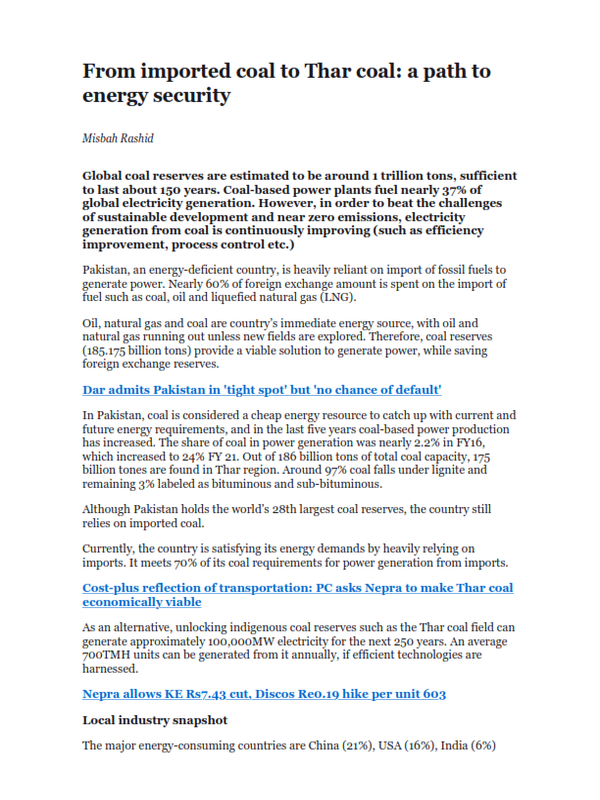From Imported Coal To Thar Coal: A Path To Energy Security
Global coal reserves are estimated to be around 1 trillion tons, sufficient to last about 150 years. Coal-based power plants fuel nearly 37% of global electricity generation. However, in order to beat the challenges of sustainable development and near zero emissions, electricity generation from coal is continuously improving (such as efficiency improvement, process control etc.)
Pakistan, an energy-deficient country, is heavily reliant on import of fossil fuels to generate power. Nearly 60% of foreign exchange amount is spent on the import of fuel such as coal, oil and liquefied natural gas (LNG).
Oil, natural gas and coal are country’s immediate energy source, with oil and natural gas running out unless new fields are explored. Therefore, coal reserves (185.175 billion tons) provide a viable solution to generate power, while saving foreign exchange reserves.
In Pakistan, coal is considered a cheap energy resource to catch up with current and future energy requirements, and in the last five years coal-based power production has increased. The share of coal in power generation was nearly 2.2% in FY16, which increased to 24% FY 21. Out of 186 billion tons of total coal capacity, 175 billion tones are found in Thar region. Around 97% coal falls under lignite and remaining 3% labeled as bituminous and sub-bituminous.
Although Pakistan holds the world’s 28th largest coal reserves, the country still relies on imported coal.
Currently, the country is satisfying its energy demands by heavily relying on imports. It meets 70% of its coal requirements for power generation from imports.
As an alternative, unlocking indigenous coal reserves such as the Thar coal field can generate approximately 100,000MW electricity for the next 250 years. An average 700TMH units can be generated from it annually, if efficient technologies are harnessed.
Local industry snapshot
The major energy-consuming countries are China (21%), USA (16%), India (6%) and Russia (5%). Pakistan’s share of global energy consumption is only 1%, 40% of which it meets through imports. According to the SAARC (South Asian Association for Regional Cooperation, 2018) report 3% and 5% custom duties are levied on the import of coal.
A historical review of Pakistan depicts that oil and gas remained the most consumed sources of energy, followed by electricity, LPG and coal. Imported coal being utilised in several industries such as power, steel, and cement manufacturing units.
The reliance on imported coal increased after the establishment of new coal fired power projects (Sahiwal and Port Qasim). In FY2022, fuel import bills exceed $20 billion.
In order to scale down fuel import costs, the country has to make serious efforts to shift towards local coal resources; a project to convert the imported coal-based power plant (Gwadar, 300MW) to a solar plant was approved in 2016 under CPEC and has yet to begin. The payment problem delayed the power project.
In Pakistan, coal consumption in power generation has increased from 2015 onwards. Whereas, in United States (US), the coal consumption in power sector is decreased by 2.3% while; in China it increased by 3.5% in 2017.
Across the border, coal fired power plants in India produce more than two third of total electricity. It imports 200 mil tons coal annually as well as utilizes domestic coal. In power plants, the average coal consumption is approx. 0.62kg/kWh. However, the new efficient power plants utilize 10% less coal as compared to the ordinary plants.
The Sustainability index of Advance Coal Technologies (ACT) in India is estimated to investigate carbon emissions. These efficient technologies (ACT) will be helpful in reducing emissions generated from coal plants. At the same time, India emphasizes installing a renewable energy system to combat CO2 emissions.
In Pakistan, the Thar coalfield development will bring prosperity in terms of economic development.
However, it is essential to improve the efficiency of the power plant by employing advanced technologies. According to the State Industry Report-NEPRA, for the development of the power plant in Thar region, an investment of $1.3billion is needed annually from 2020-2040.
Additionally, for sustainable economic growth, such as deploying clean technologies, smart power systems (carbon capturing technologies) and HDVC transmission lines, an investment of $365 million and $1658 million is required. To decarbonise the coal combustion, efficient technology options such as pre combustion and post combustion system (oxy-fuel combustion, air blown system) can be procured.
In the future, Pakistan could transition from an energy deficient to energy sufficient country if power harnessing strategies from indigenous resources are properly deployed, followed by installing efficient technologies and devising energy policies to attract investment. For this, Pakistan must rethink its energy system design.
The article does not necessarily reflect the opinion of Business Recorder or its owners




